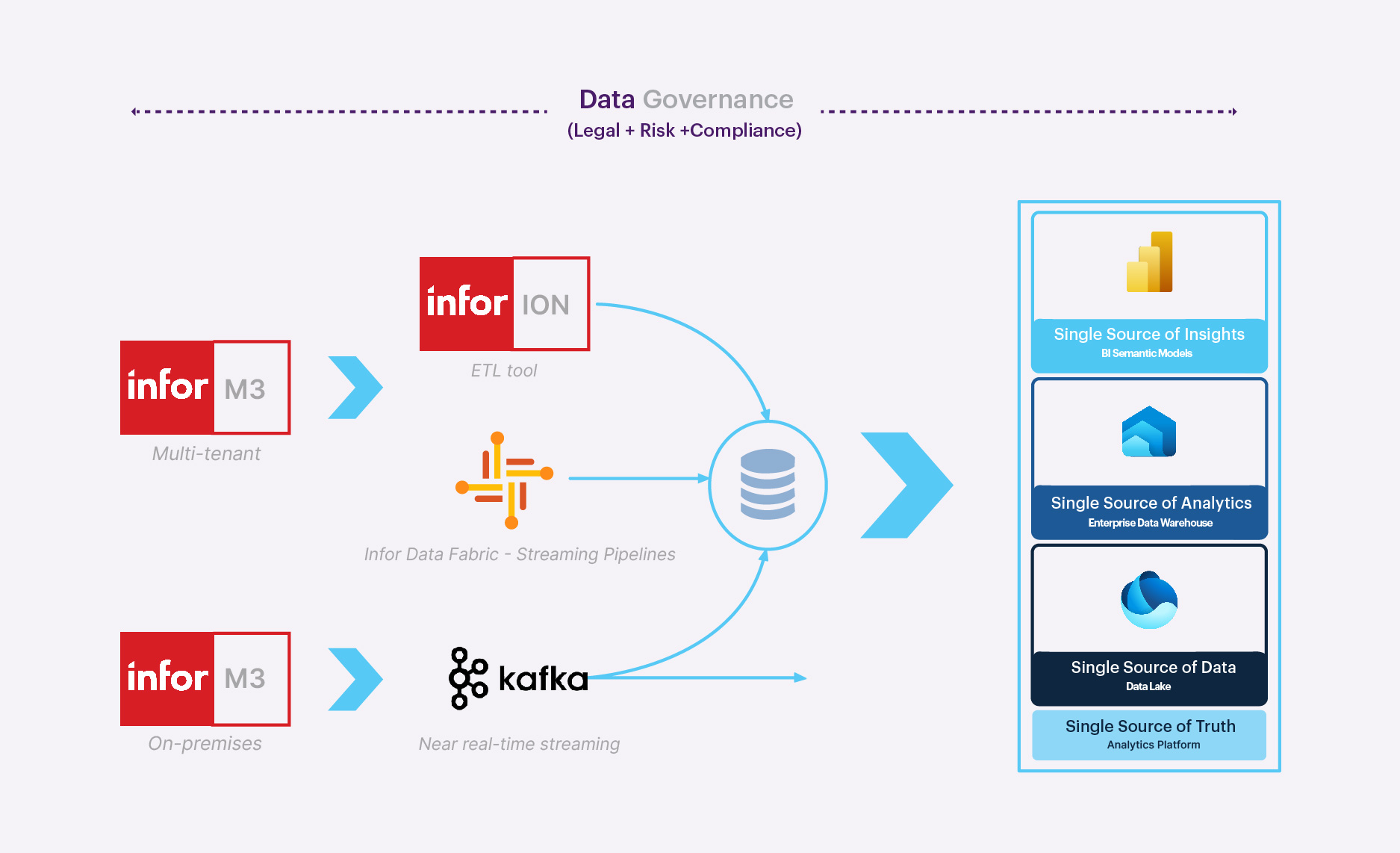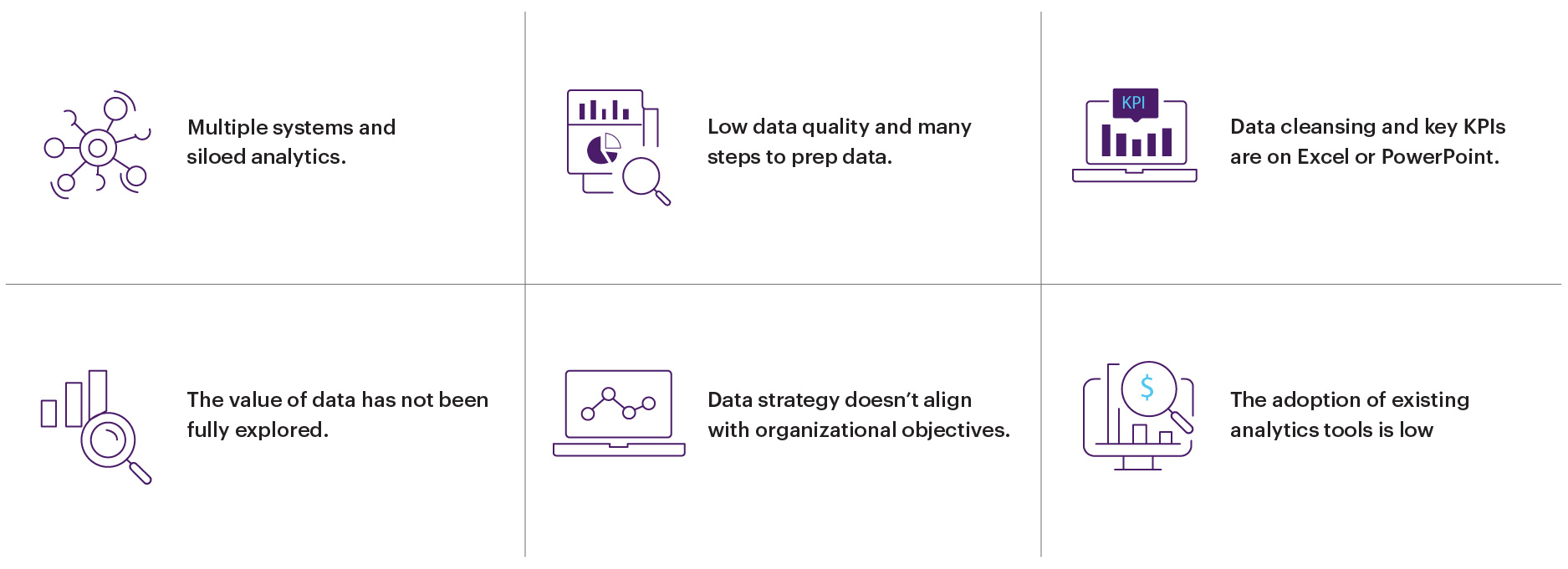It’s time to stop relying on your ERP for reporting and analytics.
Enterprise Resource Planning (ERP) systems are widely accepted as the de facto backbone of an organization, helping to streamline end-to-end business operations, from production and warehousing to finance and sales. While it is undeniable that ERPs offer businesses a significant competitive advantage, it is important to understand that your ERP can’t do it all. Nor was it meant to.
Your ERP probably does a brilliant job of gleaning data that is essential for decision-making. But this vast amount of raw operational and transactional data means very little, if you are unable to interpret and act on it. And you are not alone in facing this challenge – a Forrester study (2016) revealed that 60-73% of data goes untapped and sits within the ERP in most organizations. You may often find yourself struggling to answer some of the big questions facing your business; Should I divest an underperforming business unit? How would inflationary pressure impact my product lines going into the next year? How can I better manage my seasonal inventory? While an ERP will help address the challenges of legacy systems and aid you in moving away from spreadsheets, you need to venture beyond your ERP and other systems to find the answers to your biggest business questions and better inform your decision-making process.
Better together: How unified analytics can help you derive value from your Infor ERP
An analytics solution is no longer an option, but a necessity. While your Infor ERP manages and integrates end-to-end business processes and promotes efficiency across your supply chain, a unified analytics solution will function as a central repository for all your data by building a strong data pipeline that draws from various sources; including but not limited to your ERP. Your company probably would also be tapping into further vital systems including CRMs, other enterprise systems, and cloud sources to derive insights. A unified data solution will distill all of this unstructured and structured data into a single source of truth, consolidate, combine and contextualize the numerous data points into clear, actionable insights. Thus, your Infor M3/CloudSuite solution is complemented by data from other systems and sources, helping you translate your data into business value. Businesses that fail to leverage the full benefits of their ERP investment with a unified analytics strategy, risk leaving serious value on the table and missing out on growth opportunities.
While most leaders will agree that businesses need to be rooted in data analytics, the reality is that many struggle to realize the full potential of their ERP investments. But, even the most pervasive analytics challenges are not without solutions.
- From data silos created by disparate systems and time-consuming manual effort required to create a consolidated view…
Businesses often operate on multiple systems, producing multiple sources of data. When these disparate systems fail to speak to each other, data silos form. In a siloed system, data that is produced in one department/application cannot be accessed by users of another application so you would have to create exhausting, manual workarounds to access crucial insights.…to a unified data model that bridges the gap caused by siloed data
A unified data model integrates disparate data sources like ERP systems, CRM systems, and other data sources and consolidates them into a unified data platform. Therefore, cloud-based and on-premises data sources can be unified and accessed by different ERP systems, tools and applications, and users across various business functions or departments. For an organization that is on Cloudsuite, this would work via Infor Intelligent Open Network (ION) middleware’s ETL tool or Infor Data Fabric’s stream pipelines which collects and delivers the data to a generic data lake, data warehouse, or database. For an organization that uses Infor M3 on-premises, data can be streamed in near-real-time through Kafka or batch loads through technologies like Java Database Connectivity (JDBC).
How Fortude introduces data to an Infor M3 environment Image 1: How Fortude introduces data to an Infor M3 environment
Image 1: How Fortude introduces data to an Infor M3 environment - Ditching poor quality data…
Every year, poor data quality costs organizations an average of $12.9 million. Missing data values, incomplete inputs, duplicates, and a host of other data quality issues not only prevent businesses from making use of data, but also creates distrust in the organization’s data analytics. Whether it’s a result of human error, usage of different names or values across various systems, or shifting requirements that have created changes to the granularity of data or discontinued/newly introduced fields, the processes of prepping data for analysis can soon become a pain if not managed.…in favor of a unified data strategy and a strong data governance program.
While a unified data strategy can aid you in streamlining your data management process and reducing duplication of effort, data governance can help ensure that data quality standards are being followed. What constitutes data? Where and how is it collected, extracted, and used? Who owns and maintains the data? A unified data governance program will answer all of these questions, eliminate departmental silos and the multiple versions of the truth that come with these silos, to help create a single source of truth.A modern analytics platform not only democratizes access to data, but when supported by a robust data governance program it also allows businesses to implement role-based authorizations and ensures compliance with regulatory standards. In practice, this centralized yet flexible mechanism may look something like this; A C-suite executive would be able to access a sales dataset with all the relevant KPIs for every business region, but a regional sales manager would only be able to access the sales data for their respective sales region.
- From manual data cleansing and KPI-tracking on ever-evolving, unsecured spreadsheets…
Imagine wrangling a massive spreadsheet that is updated manually by various users whose requirements are constantly shifting, only to realize that you can’t track the historical performance of your KPIs because the data has changed since the last time you checked. Statistics show that data analysts will spend anywhere from 60-80% of their time carrying out data cleaning activities. Sounds exhausting, doesn’t it?
…to a unified, near real-time view of your end-to-end business performance with BI semantic models
A unified analytics solution acts as a base that facilitates all of the organization’s data needs. Whether you are C-suite level user who needs a high-level dashboard view of the business, or a technical user who would prefer to access the data warehouse and do their own analytics – the BI semantic model in your unified analytics platform will act as a translation layer between your enterprise applications and underlying data structures. This capability to tap into both governed and self-service analytics means that your business users don’t have to rely on your IT teams to generate and run reports nor do they have to risk mistakes when trying to replicate models in their spreadsheets. In shifting to an analytics platform that has modeled KPIs and metrics specific to your business requirements, you free your business users from concerns about the technical complexity making it much simpler for them to access the insights they need.Challenges you might be facing include,

Image 2: Challenges you might be facing include - Turning the tables on low user adoption of your analytics platform…
You just rolled out an analytics platform but find yourself back at square one because your team has abandoned the platform in favor of their ‘trusty’ spreadsheets? This resistance often stems from the fact that the analytics solution is not implemented properly or because users have a poor understanding of the value that data analytics can bring.
…with an assessment of your organization’s data analytics maturity and a clear data strategy
Part of the solution lies in effective change management and clear communication of the true value of the implementation. Another part of the solution lies in developing a data strategy and analytics roadmap that aligns with your organizational objectives, putting the right architecture in place, and identifying the analytics use cases with actual end users in mind. It also includes creating a governance framework to ensure that the analytics platform remains relevant and is able to meet the evolving needs of your business.
Establishing a Center of Excellence (CoE) that functions with discipline at the core and flexibility at the edge can help drive analytics adoption in your organization. Apart from promoting a data-driven culture, a CoE will facilitate a bottom-up approach to governance by continuously evaluating which aspects of the current data strategy works well and what doesn’t. - Tackling the ‘data issue’ that is preventing your business from adopting AI…
At the heart of AI lies a strong foundation of data analytics. Yet most IT leaders rank data issues as their top barrier to AI adoption. Part of this is due to poor integration between the various data sources that are supposed to feed data into your AI solution. This is particularly true for large organizations that have grown by acquisition and continue to maintain a network of multiple, disparate systems, some of which are legacy applications. Another problem is being unable to access the right kind of data they need for AI – some solutions run on unstructured data that is suited for record-keeping but was never intended for analysis.
…by building a solid data analytics foundation to fully leverage the power of AI
Artificial intelligence can unlock boundless opportunities for organizations to innovate and drive growth. But before venturing down the AI route, organizations must ensure that they lay the proper data foundation to avoid the risk of having to shelve AI projects midway because they are unable to access the data they need.
Take for example, the advent of Microsoft Fabric which unifies data ingestion, storage, data warehousing, business intelligence and advanced analytics capabilities through a service. It eliminates the need for data movement once ingested and also drastically reduces infrastructure management overhead, therefore allowing you to focus on what’s important with your data; innovation and growth.It doesn’t end there. AI copilots allow users to direct their biggest business questions in conversational language to their data, generate and customize reports and dashboards in seconds. This helps businesses tackle the issue of low user adoption of analytics by taking down the perceived difficulties that users may have when trying to adopt the analytics platform in their day-to-day work.
Users also have the ability to create copilots that pull insights from your data in the analytics platform and action it right back into your Infor M3/CloudSuite. This continuous digital feedback loop helps users understand how they can optimize business processes.
Turning data into more than the sum of its parts with unified enterprise analytics and Infor M3/CloudSuite
Solving your biggest data and analytics problems will require a complete pivot from traditional systems to a unified platform. While you turn to your Infor M3/CloudSuite solution to get an overview of your overall operations, your analytics platform will help garner insights into past business performance, reveal any issues that require your urgent attention, help unearth opportunities for innovation and growth with BI modeling capabilities and modern AI support. The analytics platform also democratizes access to data, thus empowering your users to truly sink their teeth into the treasure trove of data available so they can collaborate better to improve business outcomes. Simultaneously, a unified analytics platform will serve as a centralized, yet flexible data access control system allowing you to secure your business data and ensure compliance, without inhibiting growth. A truly unified analytics platform must be capable of doing all of this and more, without impacting your data security and compliance or creating complexity for your team.
Keen to start on your data analytics journey but don’t know where to start? Start with Fortude’s Data Analytics Health Check Tool to understand where you stand.
Ready to take the next step?
Subscribe to our blog to know all the things we do


